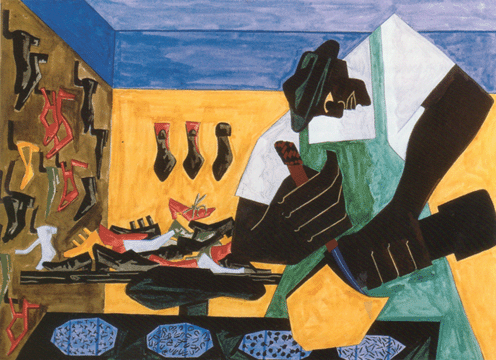Jacob Lawrence was born in 1917 in Atlantic City, New Jersey and died in 2000, Seattle, Washington. He was thirteen when he moved with his sister and brother to New York City. His mother enrolled him in classes at an arts and crafts settlement house in Harlem, in an effort to keep him busy. The young Lawrence often drew patterns with crayons. Although much of his work copied his mother’s carpets, an art teacher there noted great potential in Lawrence.

After dropping out of school at sixteen, Lawrence worked in a laundry and a printing plant. More importantly, he attended classes at the Harlem Art Workshop, taught by the African American artist Charles Alston. Alston urged him to also attend the Harlem Community Art Center, led by the sculptor Augusta Savage. Savage was able to secure Lawrence a scholarship to the American Artists School and a paid position with the Works Progress Administration. In addition to getting paid, he was able to study and work with such notable Harlem Renaissance artists as Charles Alston and Henry Bannarn in the Alston-Bannarn workshop.
Lawrence married the painter Gwendolyn Knight, who had also been a student of Savage’s, on July 24, 1941. They remained married until his death in 2000. In October 1943 (during the Second World War), he enlisted in the United States Coast Guard and served with the first racially integrated crew on the USCGC Sea Cloud, under Carlton Skinner.[2] He was able to paint and sketch while in the Coast Guard.
In 1970 Lawrence settled in Seattle and became an art professor at the University of Washington. Some of his works are now displayed there in the Paul G. Allen Center for Computer Science & Engineering and in Meany Hall for the Performing Arts. The piece in the main lobby of Meany Hall, entitled “Theatre”, was commissioned by the University for the hall in 1985.
Throughout his lengthy artistic career, Lawrence concentrated on depicting the history and struggles of African Americans. Lawrence’s work often portrayed important periods in African-American history. The artist was twenty-one years old when his series of paintings of the Haitian general Toussaint L’Ouverture was shown in an exhibit of African American artists at the Baltimore Museum of Art. This impressive work was followed by a series of paintings of the lives of Frederick Douglass and Harriet Tubman, as well as a series of pieces about the abolitionist John Brown. Lawrence was only twenty-three when he completed the sixty-panel set of narrative paintings entitled Migration of the Negro, now called The Migration Series. The series, a moving portrayal of the migration of hundreds of thousands of African Americans from the rural South to the North after World War I, was shown in New York, and brought him national recognition. In the 1940s Lawrence was given his first major solo exhibition at the Museum of Modern Art in New York City, and became the most celebrated African American painter in the country.
Shortly after moving to Washington State, Lawrence did a series of five paintings on the westward journey of African American pioneer George Washington Bush. These paintings are now in the collection of the State of Washington History Museum.[3]
He illustrated an adaptation of Aesop’s Fables for the University of Washington Press in 1997.[4][5]
Lawrence taught at several schools, and continued to paint until a few weeks before his death in June 2000 at the age of eighty-two. His last public work, the mosaic mural New York in Transit, was installed in October 2001 in the Times Square subway station in New York City.[6]
source: http://en.wikipedia.org/wiki/Jacob_Lawrence
